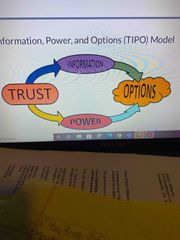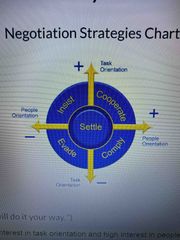![]()
![]()
![]()
Use LEFT and RIGHT arrow keys to navigate between flashcards;
Use UP and DOWN arrow keys to flip the card;
H to show hint;
A reads text to speech;
44 Cards in this Set
- Front
- Back
|
Negotiations |
A communication process involving two or more people/groups where: -The parties have a degree of difference in positions, interests, goals, values or beliefs -The party strive to reach an agreement on issues or course of action |
|
|
Trust, Information, Power, and Options (TIPO) Model |

Identifies how trust influences your use of information and how power affects the way you develop options or solutions to solve or resolve the current problem, conflict, or situation. |
|
|
Food for Thought |
Within each negotiation are variables that influence the outcome of your efforts. They are trust, information, power, and ultimately the available options. |
|
|
Trust |
The foundation of relationship with others in faith in a system. Trust in a Person Trust in a Process |
|
|
Trust in a Person |
Personal trust stands alone. It’s not reliant on any institution or third-party. Personal trust can be assumed or it can be earned through proving oneself to be trustworthy and actions and in words. |
|
|
Trust in a Process |
When you have faith in a governing institution and believe that it is supports your negotiations. Processes promote outcomes that it was justified (fair and impartial), legal, ethically acceptable, and also satisfy the interest of both negotiators. |
|
|
Power |
In a negotiation you can apply “power over “or “power with“ your opposite. “Power over” is used to gain an advantage. “Power with” improves the opportunity for mutually satisfied outcome for all negotiators involved. |
|
|
Position Powers |
Provide you the authority to make decisions, requests, and issue lawful orders based on your position. Coercive, reward, connection, and legitimate. |
|
|
Coercive |
The leaders perceived ability to provide sanctions, punishments, or consequences for not performing. |
|
|
Reward |
Deals with the leaders perceived ability to provide rewards and incentives that people like. |
|
|
Connection |
Pertains to who you know. This can erode if you use it as a primary source of influence. |
|
|
Legitimate |
This is based on one’s rank, position, or level of authority. |
|
|
Personal Powers |
Based largely on leadership traits. Referent, Information, and Expert |
|
|
Referent (Charisma) |
This power affords the opportunity to encourage, motivate, and inspire others. |
|
|
Information |
Access to secure data systems, leadership meetings, briefings, even gossip, increases this power base. |
|
|
Expert |
It suggest that you gain power in the ability to influence through your education, experience, and job knowledge. |
|
|
Options |
Different ways to potentially solve the problem. Option building requires two elements: 1. Defined the problem that needs solving. 2. Identify possible resources that may be available. |
|
|
Food for Thought |
During negotiation the TIPO model is important but it is also important to assess who we are dealing with, know what is at stake, and no the criticality of the current situation. |
|
|
Who are you dealing with? |
Understanding who we are dealing with and the importance of the relationship can help us decide the best negotiation strategy to use |
|
|
What are the stakes? |
This is considered what you stand (or are willing) to lose if negotiations go awry. If the issue is unimportant (the stakes are low), you can evade or complying with the other party. Evading maybe the right choice at first in order to allow to gather enough information to better understand the issue and to consider all options. |
|
|
What is the situation? |
During negotiation determine if the situation is an emergency, if the situation has long-term goals or if both parties are not willing to negotiate at this time. |
|
|
Negotiations Strategy Chart |

Using the NSC you can determine if your approach is Task oriented or People oriented which form the negotiation framework. |
|
|
Task orientation |
High task orientation means we are very motivated to resolve the problem or respond to a critical situation. Low task orientations means we do not wish to (or need to) resolve the situation at this time. |
|
|
People orientation |
Centers on the relationship that exist between the individuals or groups involved. Developing or maintaining a relationship is more important than the task at hand. |
|
|
NSC Comply Strategy |
Reflects low interest in task orientation high interest in people orientation. It is a passive strategy use when preservation of the relationship between you and the other party is more important than the task. |
|
|
NSC Evade Strategy |
Reflects low interest in people orientation or task orientation. The negotiator seeks to avoid engagements or negotiations. |
|
|
NSC Insists Strategy |
Reflects low interest in people orientation, but high interest in task orientation. This is a assertive winner-takes-all strategy. |
|
|
NSC Settle Strategy |
This is use when task and people orientation or similar or equal and there is a desire to develop a compromising solution. Used when there is little chance of getting everything you want but a solution is necessary. |
|
|
Cooperative Negotiations Strategy (CNS) |
Reflects high interest in people and task orientation. This strategy depends heavily on each parties collaborative efforts and desire to achieve a mutually satisfactory outcome. |
|
|
5-Step CNS Process |
Position, Interest, BATNA, Brainstorming, Solution |
|
|
Position -Planning |
Think about “what do you want“ an estimate what you think you’re counter part’s position maybe. |
|
|
Interest -Planning |
Assess the position. Why do you need the position in step one? |
|
|
BATNA (Best Alternative to a Negotiated Agreement) -Planning |
Determine your BATNA and what motivates you to engage in negotiations and estimate your counterparts BATNA now. |
|
|
Brainstorming-Execution |
Suspend judgment and develop a list of ideas and/or option proposals. |
|
|
Solution – Execution |
In this final step the best idea from all of those present it is selected by all negotiating parties. |
|
|
Readiness |
The capacity of parties to decide it is in their best interest to negotiate an agreement rather than to continue a dispute. |
|
|
Examine your Readiness |
Ask- Are these issues negotiable Am I willing to make compromise and give things up Do I want to resolve these issues equally Am I willing to work to keep the channels of communication open |
|
|
Ripeness |
Ensuring that the timing is right for successful negotiations |
|
|
Examine your Ripeness |
Do all parties know their alternatives to a negotiated settlement Are the issues negotiable |
|
|
Food for Thought |
The aspiration point is the best outcome each negotiator hope to achieve from a negotiated agreement. |
|
|
Categories of Negotiations |
Distributive and Intergrative |
|
|
Distributive |
Negotiations are usually over a single-issue and considered win-lose. Associations does tend to use hardball tactics. |
|
|
Hardball Tactics |
Good cop/bad cop, highball/lowball, exploding offer, lying, intimidation/aggressive behavior, nibble, and snow job. |
|
|
Integrative |
This category doesn’t see resources use necessarily fixed and should be approach as a win win situation. |

